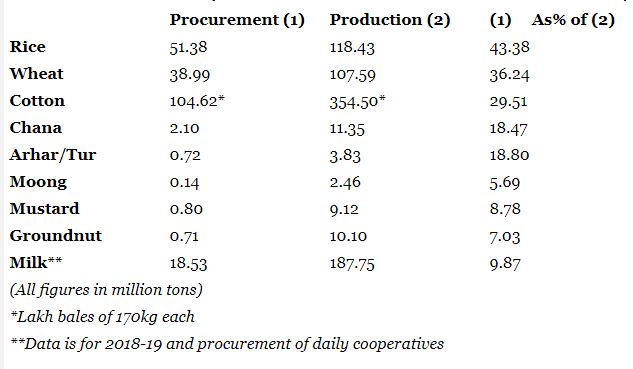- MSP or assured price system covers 25 million plus farmers across all crops
- 2015-16 Agriculture Censuses puts the total number of operational holdings at 146.45 million
- 8 million farmers are selling milk at a minimum assured price
Minimum Support Price (MSP) is the rate at which the government buys grains from the farmers. It is an essential part of India’s agricultural price today. MSP is fixed on the suggestions of the Commission at Farming Expenses and Cost (CACP).
The government of India currently fixes MSPs for 23 farm commodities:
- 7 grains (paddy, wheat, maize, bajra, jowar, ragi and barley)
- 5 pulses (chana, arhar/tur, urad, moong and masur)
- 7 oilseeds (rapeseed-mustard, groundnut, soyabean, sunflower, sesamum, safflower and nigerseed)
- 4 commercial crops (cotton, sugarcane, copra and raw jute)
The widely quoted statistic states that, “Only 6% of the Indian farmers (Ellite) benefit from Minimum Support Prices (MSP).
The source of this statistic figure has been taken from High Level Committee on Restructing of Food Corporation of India (FCI) headed by Shanta Kumar who in its report submitted in January 2015 had noticed that solitary 5.21 million of the nation’s total estimated 90.20 million horticultural family units in 2012-13 had sold paddy on wheat to pay government acquirement agencies.
The Committee, in turn, based its analysis on the National Sample Survey Offices (NSSO) in ‘Key Indicators of Situation of Agricultural Households in India’ Report for the 2012-13 farm years (July-June).
The Shanta Kumar Panel looked only at paddy and wheat procurement by the FCI but did not take into the consideration the other crops procured by other committees like:
NAFED- Chana (chickpea), arhar/tur (pigeon pea), moong (green gram), groundnut and rapeseed-mustard
Cotton Corporation of India- cotton
Daily Cooperatives- milk procurement
The table drawn below clearly states the Government Procurement v Production in 2019-20

The above percentages would be significantly higher whenever determined against actual deals by farmers. For example milk as not more than half of it would constitute marketable surplus after self-consumption by farm households.
Another example could be given of sugarcane whose pricing is governed by the Sugarcane (Control) Order, 1966, issued under the Essential Commodities Act which provides for the fixation of a ‘fair and remunerative price’ (FRP) for cane during every sugar year that is October-September.
Sugarmills are legally obliged to pay FRP within 14 days of purchase. They purchase generally 80 percent of the total crop produced. The FRP value in the 2019-20 sessions is Rs. 75, 585 crore.
According to the NSSO report, 44.84 million of India’s estimated 90.2 million agricultural households cultivated paddy during July-December 2012 and another 8.46 million in January-June 2013.
Around 35.23 million (that is 39 percent) grew wheat that year. Around 43.4 percent of India’s rice output and 36.2 percent of wheat was actually procured by the government agencies.
The Food Ministry’s own information shows that 11.06 million paddy and 4.06 million wheat farmers profited from MSP procurement in 2019-20.
Even in the wake of taking out double-counting (Punjab and Haryana farmers cultivate both crops), they would signify 13-13.5 million, which is way above the Shanta Kumar board’s estimate for 5.21 million.
The National Diary Development Board’s (NDDB) 2018-19 Annual Report has placed the total producer members of dairy cooperatives at 16.93 million. Around 8 million farmers are selling milk at a minimum assured price.
The NSSO report has estimated that complete cotton – developing family units at 7.55 million and that of sugarcane at 6.2 million. Up to 10 million of them may have profited of either MSP or FRP.
It can be reasonably inferred that the existing MSP or assured price system covers 25 million plus farmers across all crops, including pulses and oilseeds.
Hence, depending on the denominator, the 2015-16 Agriculture Censuses puts the total number of operational holdings at 146.45 million that translates into anywhere between 15percent and 25 percent.
















